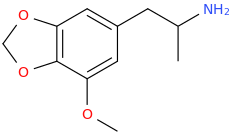Also, won't it be so polar that it has a harder time entering the brain?
I have no idea if the trifluoros prevent MAO breakdown..
I don't know whether it would be more or less polar. The thing is, when you add a fluorine substituent onto benzene, it gets slightly more lipophilic, but when you add it onto an aliphatic carbon chain, it gets slightly more hydrophilic. I guess one would just have to make this and experimentally determine logP. If the fluorine was a chlorine or bromine instead, then that would very likely make the molecule much more lipophilic, as chlorine or bromine substituted onto benzene or aliphatics increases lipophilicity much more than fluorine.
Used this website to predict logP for indole, dmt and d(TFM)t. Predicted 2.16 for indole, and experimental value is 2.14 suggesting the prediction for these compounds would be relatively accurate.
For dmt it predicted 2.30
d(TFM)t was 4.12 surprisingly. Very high. As expected, it predicted 5.97 and 6.76 respectively for the chloro and bromo derivatives. Can anyone more advanced in chemistry explain why logP was increased by so much. I'm not too sure really on why fluorine increases logP slightly on benzene but decreases it slightly on an aliphatic. I'd be grateful for a nice explanation.
As for metabolism, all I could speculate was that it would increase half life.
http://www.nature.com/nrm/journal/v13/n5/fig_tab/nrm3327_F1.html
So obviously taking a big assumption here that demethylation by MAO works in a similar way to the enzymes described above in histone demethylation. Someone studying/with a degree in biochemistry here please correct me if wrong.
In reaction a), it seems that the molecule of oxygen gets one hydrogen from the methyl group to be removed and one from the charged nitrogen. Well if the methyl group had 3 fluorines on it, then the oxygen would have to attack the fluorine. As far as I know that would make for an unstable compound. The wiki page on dioxygen difluoride says it reacts nearly every chemical it encounters. So that would suggest dioxygen monofluoride monohydrogen is of similar reactivity and would not be likely to form as much as hydrogen peroxide when metabolising normal DMT.
For reaction b), I would suspect the addition of a hydroxyl onto the TFM would be hard, and furthermore when that moiety leaves to form difluoroformaldehyde, well... I can't even find any information on that chemical. So yeah my gut instinct is it would really increase half life.
Just thinking about it now, this compound would have a high logP and increased resistance to MAO. So maybe it could be oral and equipotent to DMT (less affinity but hopefully increased logP makes up for it).


















